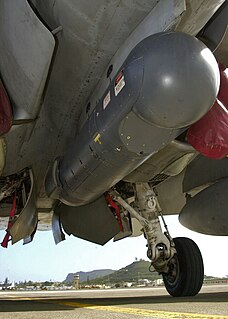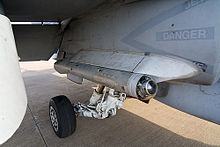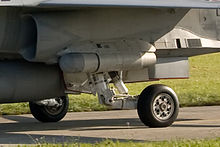
The Lockheed AC-130 gunship is a heavily armed, long-endurance, ground-attack variant of the C-130 Hercules transport, fixed-wing aircraft. It carries a wide array of ground-attack weapons that are integrated with sophisticated sensors, navigation, and fire-control systems. Unlike other modern military fixed-wing aircraft, the AC-130 relies on visual targeting. Because its large profile and low operating altitudes around 7,000 feet make it an easy target, its close air support missions are usually flown at night.

The Lockheed S-3 Viking is a four-crew, twin-engine turbofan-powered jet aircraft designed and produced by the American aerospace manufacturer Lockheed Corporation. Because of its characteristic sound, it was nicknamed the "War Hoover" after the vacuum cleaner brand.

The McDonnell Douglas F/A-18 Hornet is a twin-engine, supersonic, all-weather, carrier-capable, multirole combat jet, designed as both a fighter and attack aircraft. Designed by McDonnell Douglas and Northrop, the F/A-18 was derived from the latter's YF-17 in the 1970s for use by the United States Navy and Marine Corps. The Hornet is also used by the air forces of several other nations, and formerly, by the U.S. Navy's Flight Demonstration Squadron, the Blue Angels.

PAVE is a United States Air Force program identifier relating to electronic systems. Prior to 1979, Pave was said to be a code word for the Air Force unit responsible for the project. Pave was used as an inconsequential prefix identifier for a wide range of different programs, though backronyms and alternative meanings have been used. For example, in the helicopters Pave Low and Pave Hawk it was said to mean Precision Avionics Vectoring Equipment, but in Pave Paws it was said to mean Precision Acquisition Vehicle Entry.

Paveway is a series of laser-guided bombs (LGBs).

The Grumman A-6 Intruder is an American twinjet all-weather attack aircraft developed and manufactured by American aircraft company Grumman Aerospace and operated by the U.S. Navy and U.S. Marine Corps.

LANTIRN is a combined navigation and targeting pod system for use on the United States Air Force fighter aircraft—the F-15E Strike Eagle and F-16 Fighting Falcon. LANTIRN significantly increases the combat effectiveness of these aircraft, allowing them to fly at low altitudes, at night and under-the-weather to attack ground targets with a variety of precision-guided weapons.

A laser designator is a laser light source which is used to designate a target. Laser designators provide targeting for laser-guided bombs, missiles, or precision artillery munitions, such as the Paveway series of bombs, AGM-114 Hellfire, or the M712 Copperhead round, respectively.

The Lockheed Martin AN/AAS-35(V) Pave Penny is a laser spot tracker carried by US Air Force attack aircraft and fighter-bombers to enable them to track a laser spot on the ground. It is a receiver only, allowing the pilot to see which targets may be attacked by any laser-guided bombs they carry.

The Westinghouse AN/ASQ-153\AN/AVQ-23 Pave Spike is an electro-optical laser designator targeting pod used to direct laser-guided bombs to target in daylight, visual conditions. It contained a laser boresighted to a television camera, which displayed its image on a cockpit screen.

The AN/ASQ-228 Advanced Targeting Forward-Looking Infrared (ATFLIR) is a multi-sensor, electro-optical targeting pod incorporating thermographic camera, low-light television camera, target laser rangefinder/laser designator, and laser spot tracker developed and manufactured by Raytheon. It is used to provide navigation and targeting for military aircraft in adverse weather and using precision-guided munitions such as laser-guided bombs. It is intended to replace the earlier AN/AAS-38 Nite Hawk pod in US Navy service.

The Lockheed Martin Sniper is a targeting pod for military aircraft that provides positive target identification, autonomous tracking, GPS coordinate generation, and precise weapons guidance from extended standoff ranges.

Targeting pods (TGP) are target designation tools used by attack aircraft for identifying targets and guiding Precision-guided munition (PGM) such as laser-guided bombs to those targets. The first targeting pods were developed in conjunction with the earliest generation of PGMs in the mid-1960s.

The AN/AAQ-28(V) Litening targeting pod is an advanced precision targeting pod system currently operational with a wide variety of aircraft worldwide. The research and development of the Litening was first undertaken by Rafael Advanced Defense Systems' Missiles Division in Israel, with subsequent completion of Litening I for use in the Israeli Air Force.

An infrared search and track (IRST) system is a method for detecting and tracking objects which give off infrared radiation, such as the infrared signatures of jet aircraft and helicopters.
The GBU-44/B Viper Strike glide bomb was a GPS-aided laser-guided variant of the Northrop Grumman Brilliant Anti-Tank (BAT) munition which originally had a combination acoustic and infrared homing seeker. The system was initially intended for use from UAVs, and it was also integrated with the Lockheed AC-130 gunship, giving that aircraft a precision stand-off capability. The Viper Strike design is now owned by MBDA.

The Apache Arrowhead, is an integrated targeting and night vision system developed by Lockheed Martin for the Boeing AH-64 Apache attack helicopter. It uses second-generation long-wave Forward looking infrared (FLIR) sensors with three fields of view, a charge-coupled device TV camera, dual field of view pilotage FLIR, electronic zoom, target tracker and auto-boresight.

A large number of variants of the General Dynamics F-16 Fighting Falcon have been produced by General Dynamics, Lockheed Martin, and various licensed manufacturers. The details of the F-16 variants, along with major modification programs and derivative designs significantly influenced by the F-16, are described below.

The British Aerospace Hawk 200 is a single-seat, single engine light multirole fighter designed for air defence, air denial, anti-shipping, interdiction, close air support, and ground attack.



















